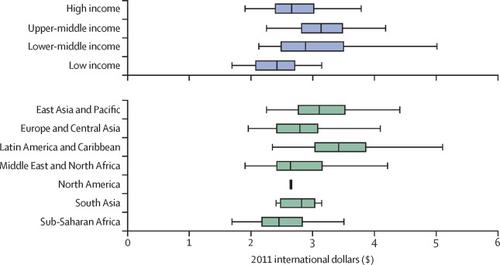The Lancet Global Health ( IF 19.9 ) Pub Date : 2019-11-07 , DOI: 10.1016/s2214-109x(19)30447-4 Kalle Hirvonen 1 , Yan Bai 2 , Derek Headey 3 , William A Masters 4

|
Background
The EAT–Lancet Commission drew on all available nutritional and environmental evidence to construct the first global benchmark diet capable of sustaining health and protecting the planet, but it did not assess dietary affordability. We used food price and household income data to estimate affordability of EAT–Lancet benchmark diets, as a first step to guiding interventions to improve diets around the world.
Methods
We obtained retail prices from 2011 for 744 foods in 159 countries, collected under the International Comparison Program. We used these data to identify the most affordable foods to meet EAT–Lancet targets. We compared total diet cost per day to each country's mean per capita household income, calculated the proportion of people for whom the most affordable EAT–Lancet diet exceeds total income, and also measured affordability relative to a least-cost diet that meets essential nutrient requirements.
Findings
The most affordable EAT–Lancet diets cost a global median of US$2·84 per day (IQR 2·41–3·16) in 2011, of which the largest share was the cost of fruits and vegetables (31·2%), followed by legumes and nuts (18·7%), meat, eggs, and fish (15·2%), and dairy (13·2%). This diet costs a small fraction of average incomes in high-income countries but is not affordable for the world's poor. We estimated that the cost of an EAT–Lancet diet exceeded household per capita income for at least 1·58 billion people. The EAT–Lancet diet is also more expensive than the minimum cost of nutrient adequacy, on average, by a mean factor of 1·60 (IQR 1·41–1·78).
Interpretation
Current diets differ greatly from EAT–Lancet targets. Improving diets is affordable in many countries but for many people would require some combination of higher income, nutritional assistance, and lower prices. Data and analysis for the cost of healthier foods are needed to inform both local interventions and systemic changes.
Funding
Bill & Melinda Gates Foundation.
中文翻译:

EAT-Lancet 参考饮食的承受能力:全球分析。
背景
EAT-柳叶刀委员会利用所有现有的营养和环境证据构建了第一个能够维持健康和保护地球的全球基准饮食,但它没有评估饮食的承受能力。我们利用食品价格和家庭收入数据来估计 EAT- 《柳叶刀》基准饮食的承受能力,作为指导改善世界各地饮食的干预措施的第一步。
方法
我们获得了 2011 年 159 个国家/地区 744 种食品的零售价格,这些价格是根据国际比较计划收集的。我们利用这些数据来确定最实惠的食品,以实现 EAT- 《柳叶刀》目标。我们将每天的总饮食成本与每个国家的人均家庭收入进行了比较,计算了最负担得起的 EAT- 《柳叶刀》饮食超过总收入的人口比例,并测量了相对于满足基本营养需求的最低成本饮食的承受能力。
发现
2011 年,最实惠的 EAT—— 《柳叶刀》饮食的全球中位数费用为每天 2·84 美元 (IQR 2·41–3·16),其中最大份额是水果和蔬菜的成本 (31·2%),其次是豆类和坚果 (18·7%)、肉、蛋和鱼 (15·2%) 以及乳制品 (13·2%)。这种饮食的成本只占高收入国家平均收入的一小部分,但世界上的穷人却无法承担。我们估计,至少 1·580 亿人的 EAT – Lancet饮食成本超过了家庭人均收入。 EAT- 《柳叶刀》饮食法的平均成本也比营养充足的最低成本贵1·60(IQR 1·41–1·78)。
解释
目前的饮食习惯与《柳叶刀》的EAT 目标有很大不同。改善饮食在许多国家都是负担得起的,但对许多人来说,需要更高的收入、营养援助和更低的价格。需要对健康食品的成本进行数据和分析,以便为当地干预措施和系统性变革提供信息。
资金
比尔及梅琳达·盖茨基金会。











































 京公网安备 11010802027423号
京公网安备 11010802027423号